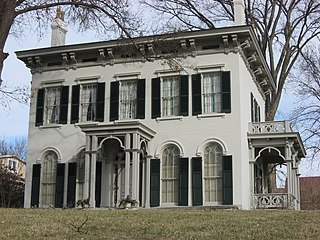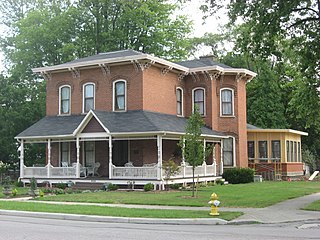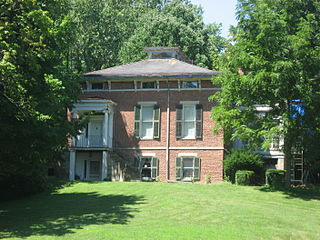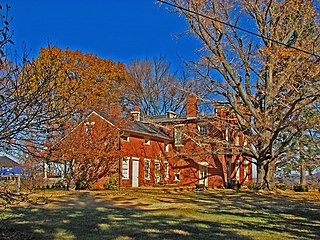William Luelleman House | |
 Front of the house | |
| Location | 120 N. Main St., New Bremen, Ohio |
|---|---|
| Coordinates | 40°26′20″N84°22′56″W / 40.43889°N 84.38222°W Coordinates: 40°26′20″N84°22′56″W / 40.43889°N 84.38222°W |
| Area | Less than 1 acre (0.40 ha) |
| Built | 1837 |
| NRHP reference # | 75001322 [1] |
| Added to NRHP | May 21, 1975 |
The William Luelleman House (also known as the Gerhard Hehemann House) is a historic house in downtown New Bremen, Ohio, United States. Designed by an unknown architect and built in 1837, [1] it is the oldest structure in the village, and it has been ranked as a leading example of German architecture on the American frontier. Among its leading details are the symmetry of the windows and doors of its facade, the glass transom windows above the doors, and the existence of a stoop rather than a porch at the entrance to the building. [2]

New Bremen is a village in Auglaize County, Ohio, United States. The population was 2,978 at the 2010 census. It is included in the Wapakoneta, Ohio Micropolitan Statistical Area. The village is adjacent to Minster to the south.

Ohio is a Midwestern state in the Great Lakes region of the United States. Of the fifty states, it is the 34th largest by area, the seventh most populous, and the tenth most densely populated. The state's capital and largest city is Columbus.

The United States of America (USA), commonly known as the United States or America, is a country comprising 50 states, a federal district, five major self-governing territories, and various possessions. At 3.8 million square miles, the United States is the world's third or fourth largest country by total area and is slightly smaller than the entire continent of Europe's 3.9 million square miles. With a population of over 327 million people, the U.S. is the third most populous country. The capital is Washington, D.C., and the largest city by population is New York City. Forty-eight states and the capital's federal district are contiguous in North America between Canada and Mexico. The State of Alaska is in the northwest corner of North America, bordered by Canada to the east and across the Bering Strait from Russia to the west. The State of Hawaii is an archipelago in the mid-Pacific Ocean. The U.S. territories are scattered about the Pacific Ocean and the Caribbean Sea, stretching across nine official time zones. The extremely diverse geography, climate, and wildlife of the United States make it one of the world's 17 megadiverse countries.
Contents
Although the house is known primarily by Luelleman's name, it has been owned and used by a succession of individuals unrelated to Luelleman and his family. It was built for community leader Gerhard Hehemann, and in later years it was home to the village's post office, a shop, and a Dutch Reformed church. Even while it was maintained for commercial or religious purposes, parts of the house continued to be used as a residence for multiple families. [2]
A post office is a public department that provides a customer service to the public and handles their mail needs. Post offices offer mail-related services such as acceptance of letters and parcels; provision of post office boxes; and sale of postage stamps, packaging, and stationery. In addition, many post offices offer additional services: providing and accepting government forms, processing government services and fees, and banking services. The chief administrator of a post office is called a postmaster.
In 1975, the Luelleman House was listed on the National Register of Historic Places because of its well-preserved historic architecture. [1] As one of the best examples of German architecture in a heavily German community, [2] it was seen as historically significant statewide. [3] Today, it is the location of a museum operated by the New Bremen Historic Association, which has owned the house since shortly after its establishment in 1973. [4]

The National Register of Historic Places (NRHP) is the United States federal government's official list of districts, sites, buildings, structures, and objects deemed worthy of preservation for their historical significance. A property listed in the National Register, or located within a National Register Historic District, may qualify for tax incentives derived from the total value of expenses incurred preserving the property.






















